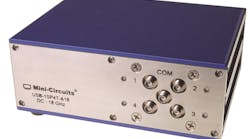USB Switch Matrix Routes DC To 18 GHz
Switching signals in a broadband test setup or other system can require careful planning and placement of low-loss switches. Alternately, it can be handled simply by adding a model USB-1SP4T-A18 low-cost Universal-Serial-Bus (USB) switch matrix from Mini-Circuits.
This rugged, low-cost single-pole, four-throw (SP4T) switch matrix operates from DC to 18 GHz with low loss and high isolation, and can handle signal power levels as high as 2 W (+33 dBm). For ease of use, the switch matrix is even supplied with operating software and a USB cable for control by a personal computer (PC) running Microsoft Windows® or Linux® operating systems, allowing a user to set any required switching configuration or sequence.
The model USB-1SP4T-A18 SP4T switch matrix (see figure) is supplied in a rugged metal case measuring 4.5 x 6.0 x 2.25 in. with SMA input connector and four SMA output connectors, a 2.1-mm DC socket, and a type B USB port. It uses absorptive failsafe break-before-make RF electromechanical switches designed for long operating lifetime—typically 100 million switching operations when channeling signal power levels of 100 mW or less (and shorter expected operating lifetimes at higher signal power levels). The metal housing also incorporates low-loss transmission lines and a dedicated microprocessor for control of the switching functions.
The broadband switch matrix is supplied with a compact disc (CD) containing a graphical-user-interface (GUI) program; the latter features an API DLL object compatible with 32- and 64-b computer operating systems. It is also shipped with a 2.7-ft. USB cable and a power adapter to furnish the 300 mA at +24 VDC needed for operation. The power adapter is suitable for use both in the United States and European Union, in addition to other power systems around the world. The switch matrix can be used with all leading test software programs, including Agilent VEE® from Agilent Technologies, LabVIEW® from National Instruments, and MATLAB® from MathWorks.
In terms of performance, the USB-1SP4T-A18 SP4T switch matrix channels signals quickly and without distortion. It features 25-ms typical switching time with insertion loss of typically 0.1 dB to 1 GHz, 0.15 dB to 8 GHz, 0.25 dB to 12 GHz, and 0.45 dB to 18 GHz. The VSWR is typically 1.05:1 to 1 GHz, 1.20:1 to 12 GHz, and 1.29:1 to 18 GHz, while the isolation per switch is typically 100 dB to 1 GHz, 90 dB to 8 GHz, 85 dB to 12 GHz, and 60 dB to 18 GHz.
The versatile USB-controlled switch matrix can greatly simplify signal routing requirements in test setups and communications and other systems. With its high isolation between ports and low insertion loss, it ensures minimal modification of any signals passing through it. The switch matrix is designed for an operating temperature range of 0 to +40°C; it can be used with its own GUI software or programmed with the included API DLL.com object for use with many other test and system-level software programs. Additional USB cables and a mounting bracket are available as options. P&A: $795 (1 to 9 qty.); stock.
Mini-Circuits, P.O. Box 350166, Brooklyn, NY 11235-0003; (718) 934-4500, FAX: (718) 332-4661, www.minicircuits.com.
